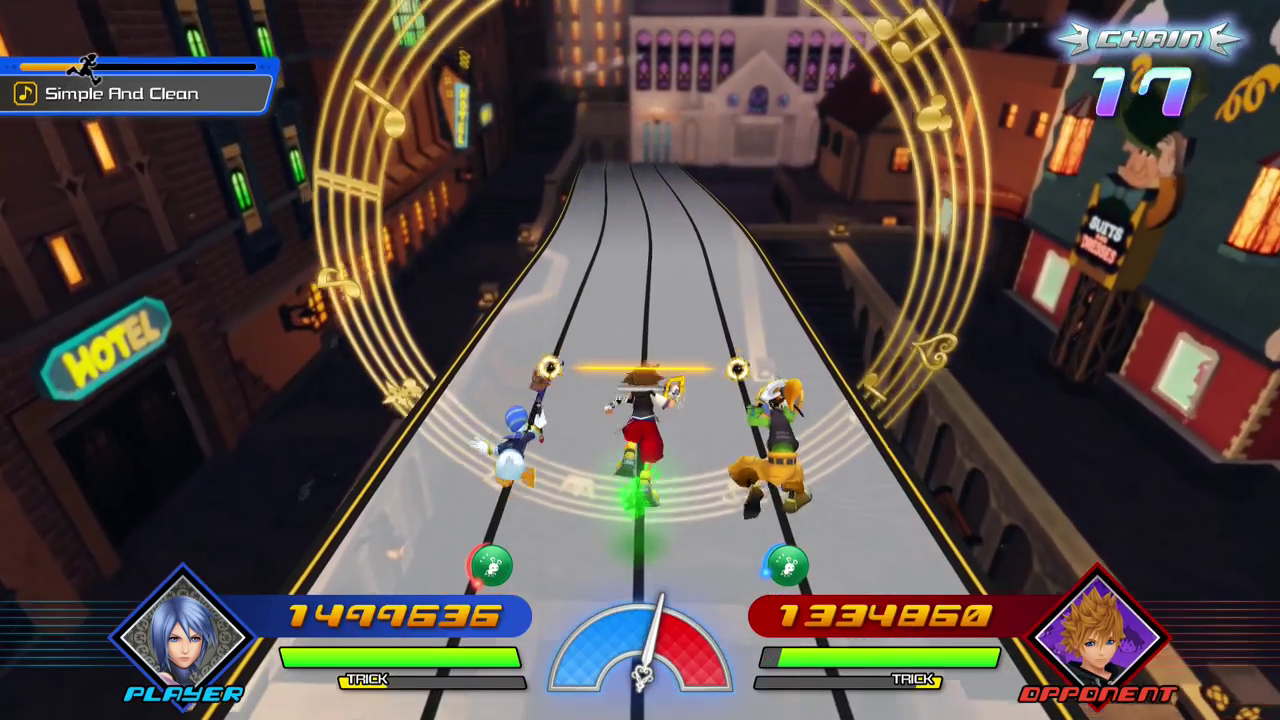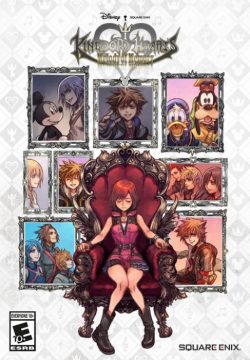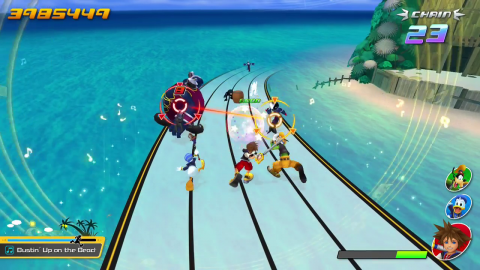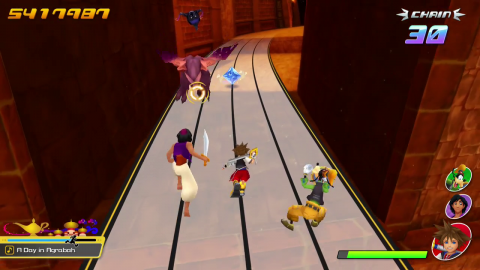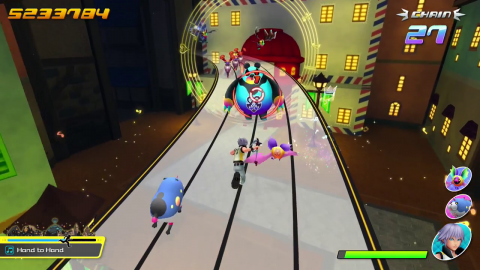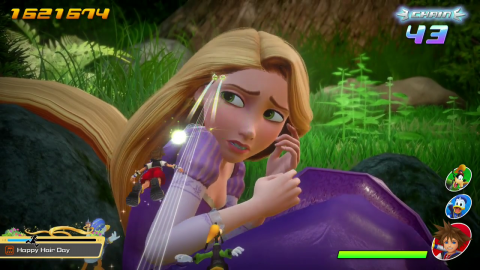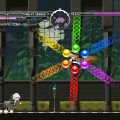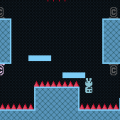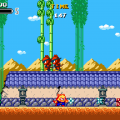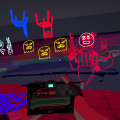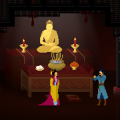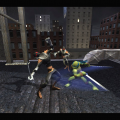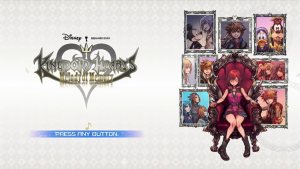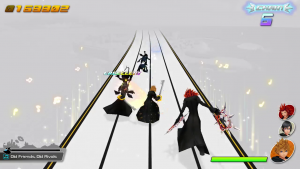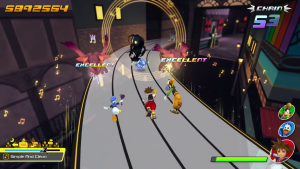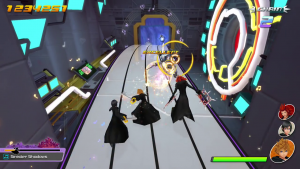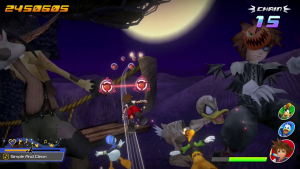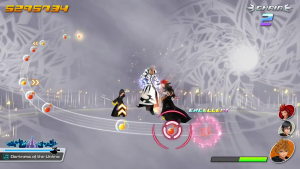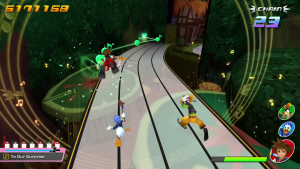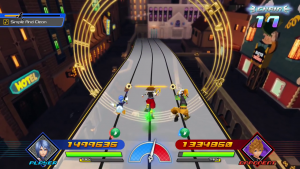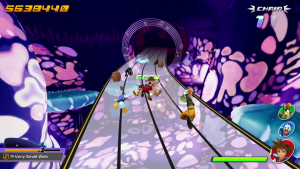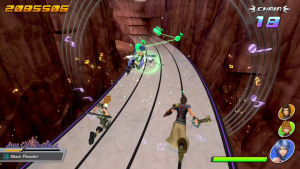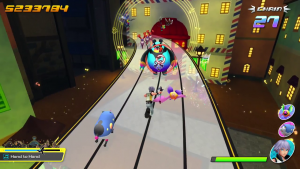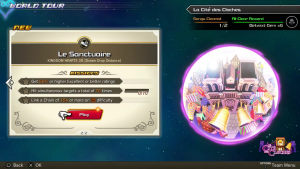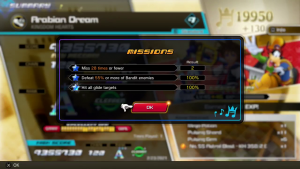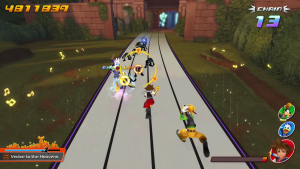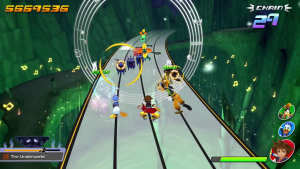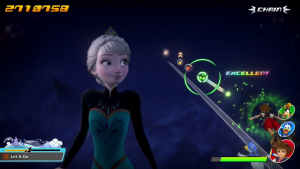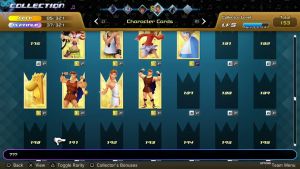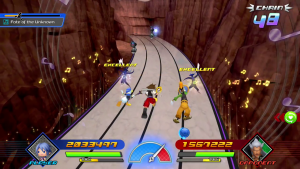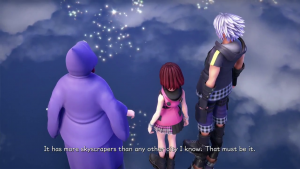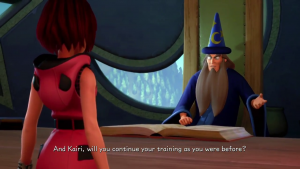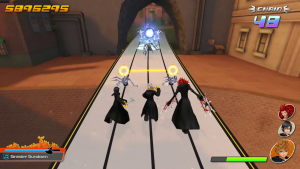- Kingdom Hearts
- Kingdom Hearts: Chain of Memories
- Kingdom Hearts II
- Kingdom Hearts: 358/2 Days
- Kingdom Hearts: Birth By Sleep
- Kingdom Hearts Re:coded
- Kingdom Hearts: Dream Drop Distance
- Kingdom Hearts χ
- Kingdom Hearts 0.2 Birth By Sleep
- Kingdom Hearts III
- Kingdom Hearts: Melody of Memory
- Kingdom Hearts (Miscellaneous)
When Square Enix released the Theatrhythm rhythm games from 2012 to 2016, they made three Final Fantasy versions and one for Dragon Quest, but Kingdom Hearts was left out, not even showing up in Theatrhythm Curtain Call‘s company-spanning DLC. Fans would have to wait until 2020, when Kingdom Hearts got its own rhythm game, Melody of Memory. Despite the delay, the influence of Theatrhythm is undeniable and a direct line of descent can be drawn between the games’ mechanics, probably thanks to their common developer, indieszero.
Melody of Memory doesn’t appear to have its own story at first, instead retelling the stories of previous games. Some have gone so far as to say this is the best way to catch up on the series’ legacy, though the coverage does get a little spotty around Kingdom Hearts III, probably because the game was still on the market. The real story only begins to develop in the final hour, when we discover we’re following a plot hook from Re:Mind: Kairi, so long neglected as a member of the core cast, has been searching her memory for hints on where to find Sora, who went missing at the end of Kingdom Hearts III.
The story is arranged in “World Tour” mode. You go from world to world completing their standard and combat themes, from most of the Kingdom Hearts series (there are no tracks from Kingdom Hearts χ). There are three challenges per song, most of which fall under the umbrella of standard play and are very easy. While each song comes in three difficulties (with each variant’s relative difficulty indicated by number from 1-15), the World Tour will generally let you use any difficulty you want. After the player hits the events of Kingdom Hearts 2, there’s usually one challenge that demands you play on Standard or higher, but you can live without it if you only feel comfortable on Beginner (Easy). As you complete songs in World Tour mode, they’re added to a general list of songs that can be easily sorted to your liking, for easy access.
Melody of Memory features three game modes: Field Battle;Memory Dive, and Boss Battles. Field Battle is definitely the central mode, and all the Boss songs and many of the Dives feature an alternate Field Battle version just to keep things under its standardized umbrella. In Field Battle, your party (selected from various trios seen throughout the series) run forward along a musical staff that twists around one of the worlds from the series. They run into to various minor enemies that serve as our “notes”. You have to wait for them to get close, and an indicator will let you know when to hit them. You can tap the shoulder buttons or the X button to defeat an enemy, and the game doesn’t care which button you hit, allowing you to use two or three buttons to hit notes faster than you could with just one, especially if your thumb is busy doing other things.Occasionally, simultaneous enemies will appear that require you to hit two or all three of the buttons: these enemies are indicated with connecting lines. If you miss an enemy, you take damage.As is standard for the genre, you’re graded on your accuracy and your score is multiplied by a chain. Strangely, the ranks for each note are “Good,” “Excellent,” and then “Excellent” again, but with a rainbow color?
Not every enemy just sits there and waits to be hit. Some enemies shoot at you, requiring to jump their attacks, and the best time to do so is marked by yet another indicator. Some enemies take multiple hits and are “knocked back” down the staff when you hit them. This makes it harder to tell what’s coming, but if you mess up and they hit you, they’re removed from the field and things get simpler. Other enemies fly or jump, requiring you to jump before hitting them, again with a matching indicator. Some large enemies lurk off the staff and have to be hit via Ability Crystals, which require you to hit Triangle when you approach it, instead (be careful, sometimes you have to use Triangle simultaneously with other buttons!). And sometimes, instead of enemies, you get barrels or boxes, which can’t hurt you but will break your chain.
Your lead character can also encounter Glide Notes: these require the player to hold the jump button to glide, and then guide them left and right with the control stick, sometimes (on higher difficulties) while their two allies continue to bash away at hostiles with L and R! The Glide Notes themselves are simple to collect, unless the camera’s wafts and wends throw you off.
Moving on from the tent pole Field Battles, Memory Dive stages follow Sora and the others as they glide over a montage of scenes from the games. These background scenes sometimes distract from the rhythm gameplay, especially with bright flashes used to stitch together scenes. The gameplay here involves hitting red standard notes, green notes that have to be held, and yellow “Slide” notes that require the player to hit the analog sticks or D-Padin certain direction. Simultaneous Slide notes can even force the player to use both sticks, while green notes might occur alongside greens, reds, or yellows alike. While this is going on, the camera sways around the musical staff, sometimes going so low that you can’t see the “horizon,” or any upcoming notes! Memory Dives are rare, with only 18 in the game. Most are from Kingdom Hearts 3, which is represented almost entirely by Memory Dives, and only one track per world, leaving most of the OST sadly untouched.
Boss stages are the same as Memory Dives, except notes come in via a curve from the left, and there are Ability Crystals in the mix. While this is happening, Sora and his friends dynamically battle a boss from the series in response to your performance. From time to time, “dark” notes will appear, which indicate the boss is going to launch some powerful attack. Your performance determines how well you avoid the attack. A moderate performance full of Goods and standard Excellents can still result in HP damage, even if you don’t necessarily miss and break your chain. Boss battles are barely in the game: there are only four in the entire package.
Like in Theatrhythm Curtain Call, Melody of Memory also allows you to use alternate “Styles,” although the Styles in question are quite different from Curtain Call. You can play in “One Button” mode, which is easier and allows you to play without worrying about jumping, hitting Triangle, or basically anything during Glide Notes! You can also play under “Performer,” which makes things harder: it adds additional notes that can’t hurt you, but award points if you can land their unorthodox button demands. Records for these alternate modes are kept separately. Neither mode is available in the storyline, which ironically means you can’t even unlock the easier mode without clear the song normally at least once!
Like Theatrhythm, there are a few RPG elements involved to spice the game up. You can choose to bring special items into each stage, and you can even summon Mickey for bonuses. You can level up, and your stats also helping you last longer when you mess up. In a strange decision, Melody of Memories gives each of your parties separate character levels, even though they’re functionally just cosmetic! There’s a synthesis system, which can unlock items and new songs, including a small set of Disney film songs, and you can also complete a rare card collection that also provides you with boosts.Like in Theatrhythm, these bonuses are mostly for casual players and not high-score chasers, because only one of them (summoning Mickey) can actually improve your score. Everything else is defensive, and survival isn’t really the goal in a rhythm game. Still, for those who are only interested in seeing the ending, getting there is quite easy.
Also like Theatrhythm Curtain Call, Melody of Memory features an online versus mode. In this mode, you and your opponent play the same Field song, and gradually fill a “Trick” meter. Once filled, one or two Tricks will be launched against your opponent, doing things like hiding the timing prompt for notes, or causing enemies to go invisible until the moment they’re about to hit you. The randomization means this mode isn’t remotely balanced, but isn’t really trying to be, either: it’s just chaotic fun. A selection of AI opponents, organized in ranks identical toCurtain Call‘s, are also available.
You can also use a couch co-op mode to play the game with a friend: the musical staff is split into two to divide your notes, and yes, you do have to hit certain targets simultaneously! Only 21 tracks are available in this mode.
